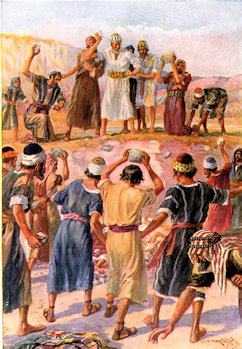The story of Jesus writing in the dust has always had a bit of mystery associated with it, because nowhere in the Bible does it state exactly what he wrote. We do know what it was about, so there have been many suggestions, both reasonable and unreasonable, as to his exact communication on that day. We will study this event, and the circumstances surrounding it, and see if we can draw any conclusions to the puzzle. Here are the Bible verses for our scripture analysis; they are John 8:1–11, which I’ve taken from the New Living Translation.1
 Jesus returned to the Mount of Olives, but early the next morning he was back again at the Temple. A crowd soon gathered, and he sat down and taught them. As he was speaking, the teachers of religious law and the Pharisees brought a woman who had been caught in the act of adultery. They put her in front of the crowd.
Jesus returned to the Mount of Olives, but early the next morning he was back again at the Temple. A crowd soon gathered, and he sat down and taught them. As he was speaking, the teachers of religious law and the Pharisees brought a woman who had been caught in the act of adultery. They put her in front of the crowd.
“Teacher,” they said to Jesus, “this woman was caught in the act of adultery. The law of Moses says to stone her. What do you say?”
They were trying to trap him into saying something they could use against him, but Jesus stooped down and wrote in the dust with his finger. They kept demanding an answer, so he stood up again and said, “All right, but let the one who has never sinned throw the first stone!” Then he stooped down again and wrote in the dust.
When the accusers heard this, they slipped away one by one, beginning with the oldest, until only Jesus was left in the middle of the crowd with the woman. Then Jesus stood up again and said to the woman, “Where are your accusers? Didn’t even one of them condemn you?”
“No, Lord,” she said.
And Jesus said, “Neither do I. Go and sin no more.”
To get the full meaning and context, it is best to start reading from John 7:1 through John 8:11, but in a synopsis, we learn that Jesus leaves for the seven-day Harvest Festival2 after his brothers had already left. “Then, midway through the festival, Jesus went up to the Temple and began to teach.” (John 7:14, NLT).
On the last day of the festival, when speaking about the Holy Spirit that believers of Jesus would soon receive, he said, “Anyone who is thirsty may come to me! Anyone who believes in me may come and drink! For the Scriptures declare, ‘Rivers of living water will flow from his heart” (John 7:37–38, NLT). This was a reference to a prophecy in Jeremiah, which states:
Lord, you are the hope of Israel;
all who forsake you will be put to shame.
Those who turn away from you will be written in the dust
because they have forsaken the Lord,
the spring of living water. (Jeremiah 17:13, NIV)
The next day Jesus came back to the temple and he began to teach again. It was at this time, that the event with the accused adulteress happens.
The woman was used as a pawn.
Concerning adultery, God’s law required that both the man and the woman must be brought to the temple and accused. Now, in this event with Jesus, the teachers and the Pharisees neither brought the man involved, nor did they bring any witnesses, unless the accusers were the witnesses themselves. In that case, they would have to testify individually, but they did not. So either way, they ignored the law.
“The woman is simply a pawn for the Jewish leaders who wish to play off Jesus’ well-known compassion for sinners…[see: Luke 7:36–50] against the demands of the law. However Jesus does not deny the woman’s sin but he draws her accusers into the circle of condemnation.”3 “The purpose of bringing this woman before Jesus was to discredit Him as a Teacher. If He condemned her, he would lose favor with the common people. If He did not, he would be disagreeing with Moses.”4 The teachers and the Pharisees came to challenge Jesus, but Jesus turned their tactical maneuver around and challenged them by stating that the one without sin should throw the first stone.
 The story says that Jesus stooped down and wrote twice in the dust of the floor. Author and member of The Society of Biblical Literature, Kermit Zarlely, wrote, “When the Bible provides a detail about a story, that detail may not be significant. But when it repeats that detail, that suggests that this information is indeed significant. So, the repeated detail about Jesus bending down and writing indicates that knowing what he wrote is essential to understanding . . . . Indeed, Jesus seems to have written something that caused these men to shut up and leave!”5
The story says that Jesus stooped down and wrote twice in the dust of the floor. Author and member of The Society of Biblical Literature, Kermit Zarlely, wrote, “When the Bible provides a detail about a story, that detail may not be significant. But when it repeats that detail, that suggests that this information is indeed significant. So, the repeated detail about Jesus bending down and writing indicates that knowing what he wrote is essential to understanding . . . . Indeed, Jesus seems to have written something that caused these men to shut up and leave!”5
Zarlely continues by implying, “With Jesus’ finger he accused and convicted each of these men of the same sin for which they were accusing the adulteress. How so? He had written the name of each of these married men and the women with whom they had indulged in illicit sex. There would not have had to have many words written in order to make his point. Certainly less words than quoting scriptures.”6
There are other suggestions, too. An edited Armenian manuscript from around the tenth century translates John 8:8 as: “He himself, bowing his head, was writing with his finger on the earth to declare their sins; and they were seeing their several sins on the stones.” This suggests that Jesus was writing, in the dust covering the temple floor stones, the sins of the very men who were accusing the woman. “It may be that Jesus was confronting those self-confident sadists with the record of their own sins.”7 And another Bible scholar had a different idea of what was written. He wrote:
“My guess is that he wrote the four words, written once before by the finger of God, in the history of Israel. In the book of Daniel there is the story of King Belshazzar who put on a great feast and drunken revels and debauchery of every type was going on. Finally, the king resorted to the ultimate blasphemy of using in the revelry the sacred vessels that had been taken from the temple in Jerusalem. Suddenly a great hand appeared and wrote four words on the wall. The king turned ashen, and all the lords and courtiers were stunned and silent. They did not know the meaning of the Persian words, ‘MENE, MENE, TEKEL, UPHARSIN,’ which appeared, so they called in the prophet Daniel to interpret them. His interpretation was, “You are weighed in the balance and found wanting.” (See: Daniel 5:25-29)8
Another thought is given by Bible commentary author Robert Tourville. He said that since, in Roman law, the judge would first write out his sentence and then pronounce his verdict from the written document, that Jesus wrote down the sentence he would soon pass.9
My Thoughts
I’ll give you my own idea, although it is not unique, for several researchers had reached the same conclusion long before me. But first, let me add a bit of additional information.
 Jewish history shows that there was a certain ceremony that would be done in order to bring judgement to those accused of a crime. The priest was required to stoop down and write the law that had been broken along with the names of the accused, in the dust on the floor.10 Being written only in the dust, the marks would not be a permanent public record.
Jewish history shows that there was a certain ceremony that would be done in order to bring judgement to those accused of a crime. The priest was required to stoop down and write the law that had been broken along with the names of the accused, in the dust on the floor.10 Being written only in the dust, the marks would not be a permanent public record.
Considering this, and the fact that Jesus spoke of the Jeremiah prophecy the previous day (see quote of Jeremiah 17:13 above), I believe that the first time he stooped down, he wrote a notation for that scripture. When the accusers again demanded an answer, he said the one without sin should throw the first stone. Then stooping the second time, he also wrote their names in the dust, because they had all turned away and forsaken God with their own sins. The men had an opportunity to receive forgiveness, just as the woman would receive, but instead of repenting at this second request, they walked away.
That passage in Jeremiah was a Messianic prophecy and we see that Jesus fulfilled it at that very moment.11 In this instance, Jesus’ message was that he was sent by God to bring salvation, not condemnation, but the accusing priests didn’t understand this. “They had forsaken the message of the Feast. They had just seen the promised Fountain of Living Waters standing before them, yet they were more interested in seeing that the law was kept to the letter.”12 Jesus effectively turned the focus of breaking the law of Moses away from the adulteress and placed it upon the Jewish teachers and enforcers of the law.
All these suggestions are purely speculation, of course, but we learn a lot just studying this encounter between Jesus and the Jewish leaders, as well as his compassion for all sinners. Every time I read this story it reminds me of a wonderful song titled “Scribbling in the Sand” (selected lyrics below).13
Amidst a mob of madmen
She stood frightened and alone,
As hate-filled voices hissed at him
That she should now be stoned.
Within the space of space and time
He scribbled in the sand.
They came to hear and see as much
As they could understand.
Now, bound by cords of kindness,
They couldn’t cast a single stone
And Jesus and the women found that they were all alone.
The Cruel Punishment of Stoning
 Stoning was cruel, but there was an important reason for it. Lacking an assigned judicial executioner, a group of people was necessary to take the life of the guilty party. And “since in the aftermath of a hail of stones, who can say which was first and which was last . . . the unanimity of the group’s action ultimately confers anonymity on each individual . . . .”14 This is similar to the later historical use of a “firing squad” after the invention of firearms. All members of the squad were instructed to fire simultaneously, preventing identification of who shot first. Many times, one or more rifles had a blank cartridge, so it was unknown exactly who even fired a fatal shot.
Stoning was cruel, but there was an important reason for it. Lacking an assigned judicial executioner, a group of people was necessary to take the life of the guilty party. And “since in the aftermath of a hail of stones, who can say which was first and which was last . . . the unanimity of the group’s action ultimately confers anonymity on each individual . . . .”14 This is similar to the later historical use of a “firing squad” after the invention of firearms. All members of the squad were instructed to fire simultaneously, preventing identification of who shot first. Many times, one or more rifles had a blank cartridge, so it was unknown exactly who even fired a fatal shot.
Also, at this time in history, it is important to note that it was impossible for the law to be carried out as per written in scripture. When Judea was captured by Roman forces, the Sanhedrin was stripped of its power to enforce the sanctions for violations of Jewish law; those found guilty could only be executed by official Roman due process. “The [Jewish] Law prescribed how and by what means an adulteress should be punished; but its application was hindered so far as regular administration was concerned, and the Romans provided no attractive alternative. No Roman judge would condemn to death a woman taken in adultery, and that was what the crowd . . . wanted, it would seem, to happen to her.”15
The Accused Woman
 Who was the accused woman brought to Jesus? Well, we don’t really know, for the Bible does not give that detail, but it has been the subject of much analytical discourse. The name Mary Magdalene is sometimes brought up as a possibility and, for some time in the early church, it was believed to be so. They also believed that the incident in the temple had inspired her discipleship with Jesus. Although most scholars do not believe it was Mary of Magdala, there are some few who still do.
Who was the accused woman brought to Jesus? Well, we don’t really know, for the Bible does not give that detail, but it has been the subject of much analytical discourse. The name Mary Magdalene is sometimes brought up as a possibility and, for some time in the early church, it was believed to be so. They also believed that the incident in the temple had inspired her discipleship with Jesus. Although most scholars do not believe it was Mary of Magdala, there are some few who still do.
This belief is derived “from the fact that Mary Magdalene was reported to have financially supported Jesus, but was listed as neither widowed, nor married, nor a mother, unlike most of Jesus’s other female followers. The conclusion was that the only way an unmarried, un-widowed, childless woman in such a society could have access to such money was through prostitution.” Could Jesus have earned her loyalty and following, because he refused to condemn her? Furthermore, Jesus was known to have dined with lawbreakers, such as tax collectors and prostitutes, in an effort to reform them. It should also be noted that many sanctuaries for reformed prostitutes and pregnant unmarried women, most notably during the 18th to the late 20th centuries, were called Magdalene asylums, institutes, or laundries by the Roman Catholic Church.16
![]()
Copyright © 2018, Dr. Ray Hermann
OutlawBibleStudent.org
→ Leave comments at the end, after References & Notes.
OBS respects your privacy and is also compliant with the European Union GDPR regulation. Click here to read.
References & Notes
- Holy Bible, New Living Translation (NLT), ©2007 by Tyndale House Foundation. Used by permission of Tyndale House Publishers, Inc., Carol Stream, Illinois 60188.
- Harvest Festival, also known as Festival of Booths or Feast of Tabernacles. During the existence of the Jerusalem Temple, it was one of the Three Pilgrimage Festivals.
“Sukkot,” (Wikipedia, Wikimedia Foundation, Inc., 11 November 2018), https://en.wikipedia.org/wiki/Sukkot - Burge, Gary M., Evangelical Commentary on the Bible, Baker Reference Library (Grand Rapids, MI: Baker Book House, 1995), vol. 3, p. 859.
- Blum, Edwin A., The Bible Knowledge Commentary: An Exposition of the Scriptures, Walvoord and Zuck, (ed.), (Wheaton, IL: Victor Books, 1985), vol. 2, p. 347.
- Zarley, Kermit, “What Did Jesus Write on the Ground?” (Patheos, 17 April 2015), https://www.patheos.com/blogs/kermitzarleyblog/2015/04/jesus-and-the-woman-caught-in-adultery/
- Ibid.
- Barclay, William, William Barclay’s Daily Study Bible, (Studylight.org, retrieved 12 November 2018), https://www.studylight.org/commentaries/dsb/john-8.html
- Stedman, Ray C., “Judging the Judges,” (Ray Stedman Authentic Christianity, 12 February 1984), https://www.raystedman.org/new-testament/john/judging-the-judges
- Tourville, Robert E., The New Testament Study Bible, The Complete Biblical Library, Ralph W. Harris (ed.), (Springfield, MO: World Library Press, 1986), vol. 5 (John), p. 223.
- Barrier, Julie, “What Did Jesus REALLY Write in the Sand?” (Crosswalk.com, 18 December 2011), https://www.crosswalk.com/blogs/dr-julie-barrier/what-did-jesus-really-write-in-the-sand.html
- Ibid.
- “What Did Jesus Write In The Sand?” (The Reality Group, retrieved 11 November 2018), https://therealitygroup.org/therealitygroup/what_did_jesus_write_in_the_sand_
- “Scribbling in the Sand,” (song), artist: Michael Card, American Christian singer-songwriter, (album: Scribbling in the Sand: The Best of Michael Card, Word Distribution / M2 Records, released 2002) – VIDEO: https://youtu.be/ic79r2_Mxl0
- Schneider, Matthew, “Writing in the Dust: Irony and Lynch-Law in the Gospel of John,” (Anthropoetics: the Journal of Generative Anthropology, UCLA, Spring/Summer 1997), http://anthropoetics.ucla.edu/ap0301/dust/
- Ibid.
- “Jesus and the woman taken in adultery,” (Wikipedia, Wikimedia Foundation, Inc., 8 November 2018), https://en.wikipedia.org/wiki/Jesus_and_the_woman_taken_in_adultery

Are you implying that the prostitute in the temple is Mary Magdalene?
No! Over the years, many people have questioned me about that possibility, so I added those two paragraphs at the end of the article, as additional information, for those that may have an interest. There are reasons to speculate that the two women are the same, however I believe there is more evidence against that possibility, than for it.
I have been studying this subject for some time and will publish an article in the future about Mary Magdalene, but currently I do not think the adulteress mentioned in John 8:1-11 was her, contrary to what the Roman Catholic Church taught for hundreds of years. I should mention that in the late 1960s, they amended their line of reasoning about this relationship.
Thank you reading this article and taking the time to comment. It is appreciated.